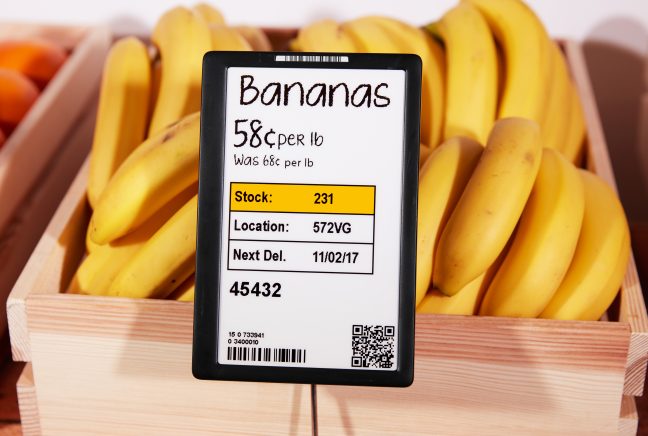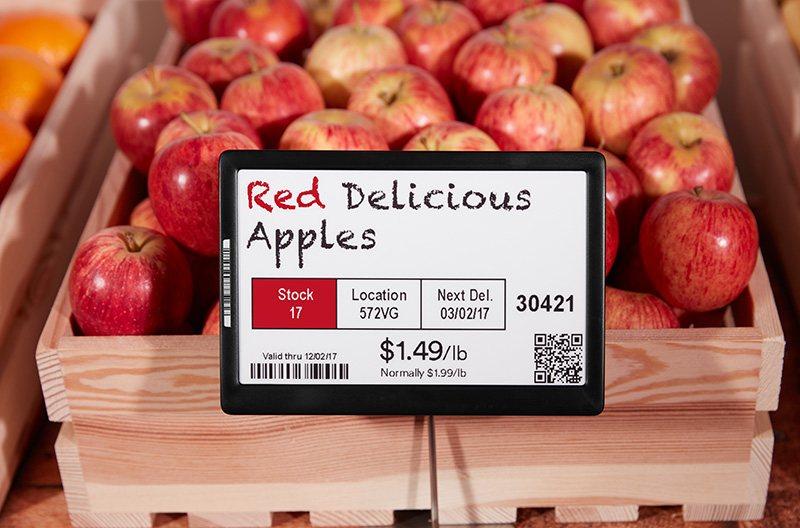In a business based on penny margins, retailers are perpetually searching for ways to optimize their pricing strategy. Lately, grocers have been turning to electronic shelf labels as part of the solution.
According to FMI’s SPEAKS 2023 report, as retailers look for more ways to use technology to improve operations and customer experience, electronic shelf labels have grown in use. In fact, 25 percent of retailers polled said they were planning on installing electronic shelf labels this past year, up from 14 percent the year prior.
“As these findings support, in a short amount of time electronic shelf labels have proven to be an effective customer-focused tool,” said Doug Baker, VP of industry relations at FMI – The Food Industry Association.
Baker noted that due to its versatile features electronic shelf labels are poised to be a game changer for retailers looking to capitalize on its wide-ranging features.
Pricing assistance
Retailers change in-store pricing on average about once a week. While most would like to do this daily and in real time, it simply wasn’t feasible up until recently. Labor shortages and a host of other reasons have made increasing the frequency of this task formidable, to say the least.
As many experts can attest, in today’s competitive landscape staying on top of pricing is critical and every missed opportunity to update it impacts the bottom line.
“The ability to change prices quickly, efficiently and accurately throughout the entire chain or at the store level in something unheard of without electronic shelf labels,” said Mark Turner, senior sales representative, American Retail Supply.
ESLs integrate with POS software and link to a store’s central database via a wireless network, allowing for information to be sent instantaneously to the shelf tag. With a click of a button retailers can update pricing easily and frequently.
And since ESLs are directly connected to the store’s database, retailers are seeing a reduction in pricing discrepancies and higher customer satisfaction levels.
“Gone are the days where the shelf edge price and point of sale price do not agree,” Turner said.
As the industry shifts toward dynamic pricing, ESLs play an important role. The ability to adjust prices in real time, based on the time of day, demand or what competitors are doing can enable even the smallest of retailers to compete more efficiently, note experts.
As an example, ESLs allow a retailer to raise prices during the most in-demand times while lowering prices during the quieter, slower times of the day. The ability to be responsive and quickly pivot to market changes, experts add, can improve profitability.
“Many departments benefit from ESLs – the first one that comes to mind is produce,” Turner said. “Say for example, the store is overstocked on bananas. With a one click the ESL and POS price for the bananas can be changed to meet demand. Additionally, wine, specifically the higher end (and more profitable) sell better when ESLs are used. These tags make it easy to display the features of that wine, tasting notes and food paring.”
Ben Norton, director of information technology for McCaffrey’s Food Markets noted his company has been using ESLs for about four years.
To balance the cost of installing the technology and its advantages, Norton said the company initially decided to deploy ESLs in a handful of departments in a couple of their stores. Norton and his team focused on using the devices in areas of the store where prices needed to be changed most frequently or where the physicality makes the task difficult to perform such as in coolers and freezers.
“We looked into ESLs because we wanted to find a way to take the pressure off our team members to maintain accurate product and pricing information,” he said. “The units we use easily integrated with our POS system and whatever changes we make are reflected on the ESL devices quickly.”
Customer friendly
While pricing features alone make ESLs stand out, experts are quick to add these small devices can do much more, particularly when it comes to improving the shopping experience.
For example, the shelf tags can be used to create a personalized shopping experience, show detailed product information, push tailored and location-based offers to smartphones and collect information on customers’ shopping behavior.
The tags also can be used to display promotional offers and QR codes. Retailers that use ESLs report being able to offer clear, accurate and real-time pricing information translates into a better overall shopping experience and builds trust.

Less labor, more sustainable
Another benefit of ESLs is associated with labor challenges. Not only does using a digital system means retailers can update prices more frequently, they no longer need to dedicate employee time to manually updating traditional paper labels. Store associates can be redirected to other tasks and focus on service in the store.
When it comes to technological advancements including ESLs, Baker said retailers that view these devices as a business aid versus an adversary are those that can operate the most efficiently. “The more we can automate business processes and engage consumers the more effective retailers can be,” he added.
McCaffrey’s Food Markets has chosen to use a combination of ESLs and traditional tags and, according to Norton, that strategy likely will be used in its other stores when the time comes.
“ESLs have freed up our team to check and maintain the printed labels we still use. What’s more, many of our associates appreciate no longer needing to hang tags in the frozen and dairy departments where ESLs have been deployed,” he said.
And for retailers with a sustainability platform, those that switch to this digitally based option reduce their carbon footprint by significantly decreasing the amount of paper they use.
Key benefits of electronic shelf labels
- Fast and accurate – Direct updates are done automatically and translate to real-time pricing. Staff that would typically be inputting pricing changes can be deployed elsewhere in the store.
- Dynamic pricing – ESL technology takes several factors into account and can tweak prices based on market changes.
- Enhanced customer experience – Beyond pricing ESL tags can be used to display detailed product information, promotional offers, QR codes and other marketing info.
- Sustainability points – going digital means less resources are used for pricing and marketing, decreasing waste and the retailer’s footprint.
Read more technology news from The Shelby Report.

